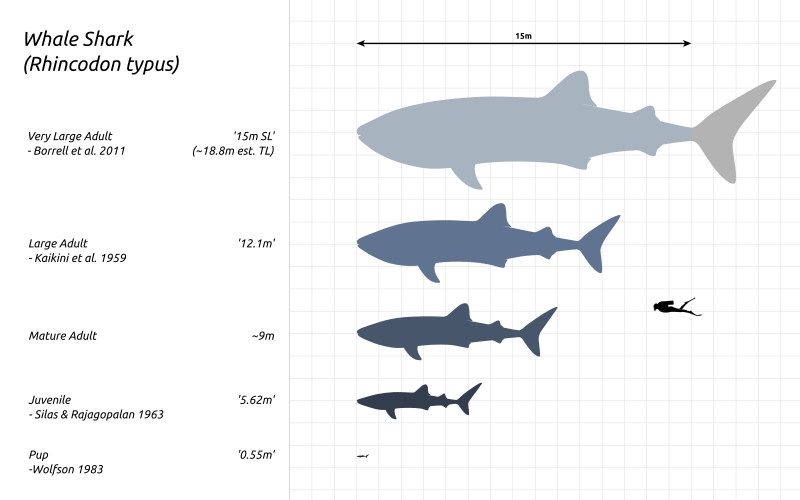Image: Whale-Shark-Scale-Chart-SVG-Steveoc86

Description: The size and growth of the whale shark (Rhincodon typus). • Whale shark silhouettes scaled to measurements of various individuals reported in the literature and influenced by whale shark images found online. • There is the possibility of error when measuring a shark's total length, which can vary depending on the method used to calculate it. Some reports calculate total length by adding on the caudal fin to the pre-caudal length, or by stretching the caudal fin to the maximum possible (referred to as stretched total length). These methods ignore the angle the tail naturally sits and artificially increases the total length of the shark. The other method is to try and pose the shark's tail fin to a lifelike position; however, this is difficult in large sharks. Any inaccuracy in the positioning of the tail can affect the reported total length measurement.[1] Whale sharks in this image might not match the reported total length because of this. Many reports don't specify whether measurements were taken straight-line distance or over the curves of the body, which could be another source for error. • The smallest individual in the chart is based on measurements of a 'pup' described by Wolfson 1983, reported as 55cm.[2] • The 'juvenile' individual is based on measurements in Silas & Rajagopalan 1963, reported as 5.62m.[3] • Evidence mainly from male whale sharks suggests that they are sexually mature at around 8-9m in length (9m shown here). Females might mature at a similar size or larger.[4][5][6] • The 'large adult' silhouette is based on measurements of a whale shark caught in 1959, reported as 12.1m.[7] (Note; the precaudal length was reported at 9.84m, and the upper caudal fin was 2.31m. To reach the reported total length of 12.1m would require the upper caudal fin to be illustrated at a shallow angle. This might imply it was measured as 'stretched total length' or over the curves.) • Whale sharks exhibit size sexual dimorphism, with males reaching smaller sizes than females. Meekan et al. (2020) estimated that males reach an average of 8-9m; this is an average, not a maximum possible male size. There is less data for females, but Meekan et al. (2020) estimated an average of ~14.5m for females.[8] • The largest size possible for whale sharks is uncertain. Reports suggest individuals round ~18m, but many of these reports lack detailed measurements or documentation. The largest silhouette is scaled to 15m standard length, based on an individual reported with a by Borrell et al. 2011. The total length was not documented; the authors estimated the total length at 18.8m using an equation.[9] McClain et al. 2015 consider this whale shark as the largest reliably measured.[10] • Human diver scaled to ~1.8m. Silhouette extracted from File:Sperm_whale_size.svg. References ↑ Rowat, D. (2012). "A review of the biology, fisheries and conservation of the whale shark Rhincodon typus". Journal of Fish Biology 80 (5): 1019–1056. DOI:10.1111/j.1095-8649.2012.03252.x. ISSN 1095-8649. ↑ Wolfson, F. H. (1983). "Records of seven juveniles of the whale shark, Rhiniodon typus". Journal of Fish Biology 22 (6): 647–655. DOI:10.1111/j.1095-8649.1983.tb04224.x. ISSN 0022-1112. ↑ Silas, E. G. (1963). "On a recent capture of a whale shark (Rhincodon typus Smith) at Tuticorin, with a note on information to be obtained on whale sharks from Indian waters". Journal of the Marine Biological Association of India 5 (1): 153-157. ↑ Colman, J. G. (1997). "A review of the biology and ecology of the whale shark". Journal of Fish Biology 51 (6): 1219–1234. DOI:10.1111/j.1095-8649.1997.tb01138.x. ISSN 1095-8649. ↑ Stevens, J. D. (2007-03-01). "Whale shark (Rhincodon typus) biology and ecology: A review of the primary literature". Fisheries Research 84 (1): 4–9. DOI:10.1016/j.fishres.2006.11.008. ISSN 0165-7836. ↑ Norman, Bradley M. (2007-03-01). "Size and maturity status of the whale shark (Rhincodon typus) at Ningaloo Reef in Western Australia". Fisheries Research 84 (1): 81–86. DOI:10.1016/j.fishres.2006.11.015. ISSN 0165-7836. ↑ Kaikini, A. S. (1959). "A note on the whale shark Rhincodon typus Smith, stranded off Mangalore". Central Marine Fisheries Research Unit, Mangalore.. ↑ Meekan, Mark G. (2020). "Asymptotic Growth of Whale Sharks Suggests Sex-Specific Life-History Strategies". Frontiers in Marine Science 7. DOI:10.3389/fmars.2020.575683. ISSN 2296-7745. ↑ Borrell, Asunción (2011). "Stable isotope profiles in whale shark (Rhincodon typus) suggest segregation and dissimilarities in the diet depending on sex and size". Environmental Biology of Fishes 92 (4): 559–567. DOI:10.1007/s10641-011-9879-y. ISSN 0378-1909. ↑ McClain, Craig R. (2015-01-13). "Sizing ocean giants: patterns of intraspecific size variation in marine megafauna". PeerJ 3: e715. DOI:10.7717/peerj.715. ISSN 2167-8359.
Title: Whale-Shark-Scale-Chart-SVG-Steveoc86
Credit: Own work
Author: Steveoc 86
Usage Terms: Creative Commons Attribution-Share Alike 4.0
License: CC BY-SA 4.0
License Link: https://creativecommons.org/licenses/by-sa/4.0
Attribution Required?: Yes
Image usage
The following page links to this image:

